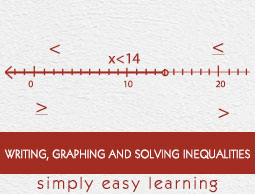
- Writing, Graphing and Solving Inequalities
- Home
- Translating a Sentence by Using an Inequality Symbol
- Translating a Sentence into a One-Step Inequality
- Introduction to Identifying Solutions to an Inequality
- Writing an Inequality for a Real-World Situation
- Graphing a Linear Inequality on the Number Line
- Writing an Inequality Given a Graph on the Number Line
- Identifying Solutions to a One-Step Linear Inequality
- Additive Property of Inequality with Whole Numbers
- Multiplicative Property of Inequality with Whole Numbers
- Solving a Two-Step Linear Inequality with Whole Numbers
- Solving a Word Problem Using a One-Step Linear Inequality
Translating a Sentence into a One-Step Inequality
Introduction
We have already been introduced to inequalities, which show the relationship between two quantities that are not equal. Here sentences are given, which need to be translated into one-step inequalities.
Rules to write one-step inequalities
A sentence generally has three parts, the left, the middle and the right ones.
We proceed from the left part, which usually contains the variable and translate into an expression.
We write the inequality sign from the middle one.
We then write the expression for the right part of the sentence, which is usually a number.
The examples below explain the above rules
Example 1
Nine subtracted from b is greater than or equal to 21
Solution
Step 1:
We start from the left and proceed towards the right
On the left, there is 9 subtracted from b and on the right, there is 21 and the inequality greater than or equal to in the middle
Step 2:
Nine subtracted from b translates to b 9
So, the statement Nine subtracted from b is greater than or equal to 21 translates to
b 9 ≥ 21
Example 2
Seven more than a is less than or equal to 18
Solution
Step 1:
We start from the left and proceed towards the right
On the left, there is 7 more than a and on the right, there is 18 and the inequality less than or equal to in the middle
Step 2:
Seven more than from a translates to a + 7
So, the statement Seven added to a is less than or equal to 18 translates to
a + 7 ≤ 18